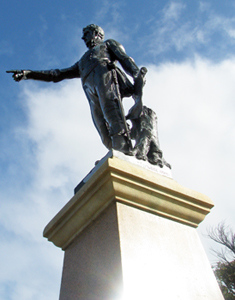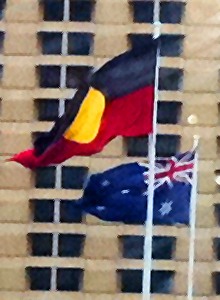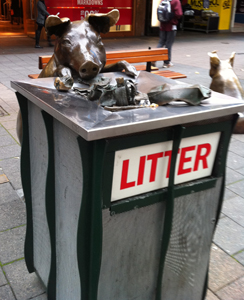When Americans think of Australia, we tend to think of Sydney or Melbourne, the Great Barrier Reef, the outback, kangaroos and koalas. Of course, there's a lot more to discover in this fascinating country and chance -- specifically the fact that I happen to have family there -- took me to the city of Adelaide, capital of South Australia, a place not generally excluded from tourists' itineraries.

With over 1,000,000 residents, Adelaide is the fifth largest city in the nation. It is named after the wife of King William IV and was established in 1836 as the freely settled capital of the new state. That it was freely settled is a point of great pride for its citizens. This was a city built by people who wanted to be there, not by convicts who didn't, like Sydney or Melbourne.
The site of the city and its layout are the work of Col. William Light, first Surveyor-General of South Australia. His statue (right), portraying him pointing out over the city, stands as a memorial (right), as does the fact that he is the only person ever buried within the "square mile" city center.

Adelaide takes its history very seriously and that is to the benefit of visitors. The city's awareness of its indigenous people is quite keen. For example, the Aboriginal flag, declared "official" by the government in 1995, is flown beside the national flag familiar to most of us.
Designed by Aboriginal artist Harold Thomas in 1971, the yellow circle in the center represents the sun; the black represents the people and the red represents the "red ochre" of the earth.
At public ceremonies in Adelaide there is an acknowledgment that the land on which the city was built is the traditional home of the Kaurna (most often pronounced "Ga-na") people, one of the hundreds of groups that populated the country when the Europeans settled there in the eighteenth century. Each had its own language. Today, the estimate is that about 150 indigenous languages remain.
Before public or official gatherings, the person serving as host will say, "We would like to acknowledge this land that we meet on today is the traditional lands for the Kaurna people and that we respect their spiritual relationship with their country. We also acknowledge the Kaurna people as the custodians of the Adelaide region and that their cultural and heritage beliefs are still as important to the living Kaurna people today."
Many of the place names here are Aboriginal. For example, Morialta Conservation Park a few miles northeast of the city derives its name from the Kaurna word for "ever-flowing" or "running water" in acknowledgment of the waterfall there.
But the centerpiece of that preservation in Adelaide is Tandanya, the National Aboriginal Cultural Institute. Tandanya is the Kaurna word for "red kangaroo place," a fact reflected in the museum's logo (left at bottom). There are galleries, performances and the opportunity to learn about aboriginal culture through artifact exhibitions and the work of contemporary Aboriginal artists.

The recurring pattern of most aboriginal art works is a series of dots, circles of all sizes and colors. An artistic tradition from earlier times, when aboriginal artists portrayed the landscape around them from an aerial point of view, painters still use these dots. Even people and parts of bodies are constructed of a series of dots.
The Art Gallery of South Australia, celebrating its 130th birthday this year, was completely refurbished to best showcase Australian art. There is work by Col. Light in the Gallery and several by artists brought over by Captain Cook. There is also some "tourist art," shields and the like made by Aboriginal artists specifically for tourists to take back home.
The South Australian Museum, which is reminiscent of theMuseum of Natural History in New York, only on a smaller scale, showcases the native flora and fauna of the country and of other parts of the world.
All of these museums are free. The exceptions are some special exhibitions and performances at Tandanya, where a moderate admission is requested.
Art can also be found outdoors. The pig rooting through trash in the middle of a downtown Adelaide mall is a playful example.
The city of Adelaide -- and everything in it -- is easily navigated and accessible. Open malls, heaps of parkland, coffeehouses, restaurants -- all the amenities are available and welcoming.
SA license plates are imprinted with the slogan: "The Festival State," a truth confirmed by a look at entertainment listings, tourist materials and alternative press. During June, which is winter in Australia, two festivals, the Adelaide Cabaret Festival and the Adelaide Cabaret Fringe Festival are held. There are about two dozen other festivals throughout the year.
The city's arts scene is also vibrant. It is packed with galleries, cinemas, clubs, theaters in which community productions of plays are show, along with professional shows and those done by the State Theatre and State Opera Companies of South Australia.
On the outskirts of Adelaide lie the mountains, the conservation areas and one very quaint town. After a few days in Adelaide, we decided to go and meet the four-legged natives and I will share those adventures next.
Photos of statue, flags and sculpture,: Ellen Sterling
